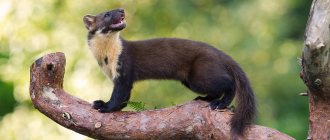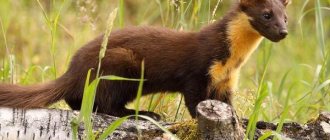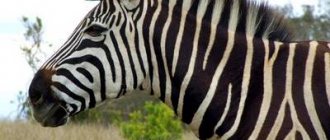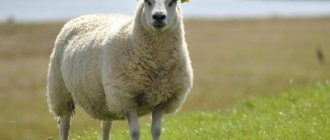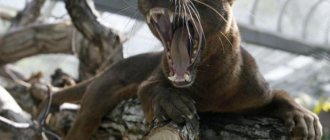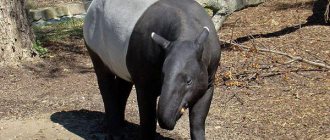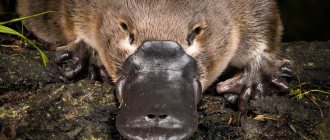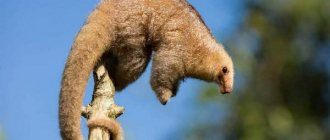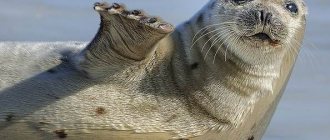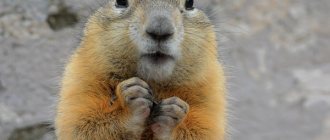Description and features
Kharza can be classified as a medium-sized predator. The general body structure of the kharza is similar to all martens. Agility and agility are recognized in the flexible, elongated body, strong legs and long tail. The weight of a mature male in a well-fed season can reach 3.8–4 kg. The length of the body is up to 64-70 cm. The tail extends to 40-45 cm.
The head is small. The length of the skull is 10-12% of the length of the body. The width of the skull is slightly shorter than the length. The shape of the skull, when viewed from above, is triangular. The base of the triangle is the line between the small, rounded ears. The apex is the coal-black tip of the nose. The upper part of the muzzle is dark brown, almost black, the lower part is white.
The body rests on not very long limbs. The back pair is noticeably more muscular and longer than the front pair. Both are lightly covered with fur and end in five-fingered paws. Kharza is animal . Therefore, the kharza’s paws are well developed, from claws to heels.
Kharza is the largest of the genus of martens and the most brightly colored
The entire body of the animal, with the exception of the tip of the nose and fingertips, is covered with fur. There is short, hard fur even on the soles. In terms of the length of fur hair, the kharza lags behind its relatives. Even her tail is faintly covered with fur. Summer fur is tougher than winter fur. The hair is shorter and grows less frequently.
The not very high quality of wool and undercoat is compensated by its unique color. Kharza looks impressive in the photo. The color scheme clearly belongs to a tropical animal and looks especially unusual in the harsh Far Eastern taiga.
The top of the animal's head is black with a brown tint. On the cheeks the coat has acquired a reddish tint, the hair of the main color is interspersed with white hairs at the ends. The back of the ears is black, the inner part is yellowish-gray. The back of the head is brown with a golden-yellow sheen. The scruff of the neck and the entire back are painted this color.
On the sides and belly the color becomes yellow. The neck and chest of the animal are most brightly colored in orange and light gold. The upper parts of the forelimbs are brown, the lower parts and paws are black. The hind limbs are colored similarly. The base of the tail is gray-brown. The tail itself is jet black. There are purple reflections at the tip.
All mustelids, including the harza, have anal glands. These organs secrete a secretion that has a persistent, unpleasant odor. In peaceful life, the secretions of these glands are used to inform other animals about their presence, this is especially important during the mating season. In case of fright, the emitted aroma is so strong that it can scare away the predator that attacked the harza.
Kinds
Yellow-throated marten, Far Eastern harza , Nepalese marten, chong wang - this is the name of the same animal, which is included in the biological classifier under the Latin name Martes flavigula or harza. She is part of the genus of martens. In which are located:
- fishing marten (or ilka),
In the photo Ilka marten
- American, forest, stone marten,
Because of the white fur on its chest, the stone marten is called the white marten.
- Kharza (Far Eastern, Ussuri marten),
- Nilgiri Kharza,
- Japanese and common (Siberian) sable.
Similarity in color and size can be seen between the Ussuri predator and the rare Nilgiri harza living in southern India. External similarity gave rise to similar names. An epithet associated with her habitat - the Nilgiri hills - has been added to the name of a resident of India.
Kharza is a monotypic species, that is, it is not divided into subspecies. High adaptive capabilities allow it to exist in the Burmese swamps and desert mountains of Pakistan, and the taiga thickets of Siberia. Based on the nature of the territories in which this predator lives, the following types of harza :
- forest,
- swamp,
- mountain-desert.
Territorial features are usually followed by changes in diet, hunting methods, and other living habits. Which can directly affect morphological and anatomical characteristics. But the harza remained true to itself and is still represented only as Martes flavigula.
Range, habitats
The Nepalese marten lives in Nepal (which makes sense), as well as India, Bhutan, Pakistan, Bangladesh, Myanmar, Afghanistan, China and South/North Korea. The distribution area covers the Malacca and Indochinese peninsulas, the islands of Hainan, Taiwan, Java, Borneo and Sumatra, reaching (in the western part of the range) to the borders of Iran.
In Russia, the Ussuri marten has settled down in the Primorsky and Khabarovsk territories (Sikhote-Alin), the river basin. Ussuri, Amur region, in the Jewish Autonomous Okrug and the Amur region (partly). Acclimatization of the harza continues in Crimea (near Yalta), Krasnodar Territory (near Novorossiysk and Sochi), as well as in North Ossetia, Dagestan (near Derbent) and Adygea.
Important! Its range includes the humid tropics and highlands, Siberian taiga and sea coasts - and almost everywhere the harza chooses tall, dense forests, little touched by humans.
In Primorye, the marten is seen in mixed forests growing on mountain slopes (far from civilization), but in southern countries it also inhabits wetlands, and in the north-west of the Himalayas - among bush-covered rocks and in juniper woodlands.
Return to content
Lifestyle and habitat
Kharza lives in very different biospheres. Its range stretches from northern India to the Russian Far East. It is often found in Indochina and successfully survives on the Korean Peninsula and the Indonesian islands. It is adapted for living and hunting in many ecological systems, but feels best in the forest.
Yellow-breasted martens live and hunt in small groups of 3 to 7 animals. Often the core of the group is a female with puppies from last year's litter. Group hunting is especially effective in winter. As summer approaches, the predator community may disintegrate. That is, the harza is characterized by life in a semi-permanent flock with an unidentified hierarchy.
Kharza leads a very active lifestyle
The yellow-breasted marten can hunt for food at any time of the day. She does not have the ability to see in the dark, so she hunts on cloudless nights when the moon shines bright enough. Kharza relies on his sense of smell and hearing no less than his eyesight.
In addition to excellent vision, hearing and sense of smell, speed qualities are added, which the predator realizes mainly on the ground. The animal moves, resting on its entire foot. The increased support area allows you to quickly move not only on hard soil, but also on swampy or snow-covered areas.
The kharza can overcome impassable areas by jumping from tree to tree, from branch to branch. The ability to move quickly on different types of soil, alternating running on the ground with jumping through trees gives an advantage when pursuing a victim or escaping from pursuit.
There are not many enemies that yellow-breasted martens have to fear. At a young age, teenage animals are attacked by the same martens or lynxes. In an open space, a sick, weakened harza can be caught by a group of wolves. Most predators know about the harza's secret weapon - glands that secrete a liquid with an unpleasant aroma - and therefore attack it extremely rarely.
The main enemy of the harza is man. People are not interested in the yellow-breasted marten as a source of meat or fur. Fur and meat are of low quality. Professional hunters seriously believe that the kharza destroys too many musk deer, deer, and elk calves. Therefore, yellow-breasted martens are classified as pests and are shot in the same way as wolves or raccoon dogs are shot.
Much greater damage to the mustelid population is caused by non-hunters seeking to preserve deer or elk. The main enemies of animals living in the taiga are loggers. Mass deforestation is the destruction of a unique Far Eastern biocenosis, an attack on all living things.
Nutrition
On Russian territory, in the Far Eastern taiga, the kharza occupies the position of one of the most powerful predators. She, of course, cannot compare with the Amur tiger or leopard. The size of the harza , aggressiveness and nature of its prey place it on the same level as the lynx. The smallest victims are insects. Not less often than beetles and grasshoppers, chicks and small birds enter its diet.
Climbing ability and agility have made the harza a constant threat to bird nests and animals living on the lower and middle floors of the forest. Hiding in a hollow, a squirrel or a bat does not receive guarantees of safety. Kharza penetrates into the most hidden hiding places in tree trunks. Kharza does not spare other, smaller representatives of mustelids.
In hunting for rodents, the harza successfully competes with small and medium-sized taiga predators. Secretive and fast hares periodically find the yellow-breasted marten for lunch. Juvenile ungulates often suffer from harza. Piglets and calves from wild boar to wapiti and elk are eaten by the yellow-breasted marten, despite protection from adult animals.
Kharza is one of the few taiga predators that have mastered collective methods of attack. The first technique is ambush hunting. A group of several yellow-breasted martens chases the prey to an ambush site. Another hunting technique is to drive the ungulate onto the ice of a river or lake. On a slippery surface, the deer loses its stability and the ability to hide from its pursuers.
Small deer, especially musk deer, are the favorite hunting trophy of the kharza. Baiting one animal provides food for several predators for many days. Collective hunting is practiced mainly in winter. With the onset of spring and the appearance of offspring, most inhabitants of the taiga no longer need organized actions.
What does the harza eat?
Photo: Ussuriyskaya Kharza
The main part of the diet is small ungulates. The predator gives preference to musk deer: the more this hornless ruminant is in the region, the higher the number of this representative of mustelids.
He also hunts cubs:
- deer;
- spotted deer;
- moose;
- wild boar;
- roe deer;
- gorala;
- doe.
The weight of prey, as a rule, is no more than 12 kg. The beast attacks little pandas. Part of the menu consists of hares, squirrels, voles and other rodents. Of the birds, hazel grouse or pheasants, eggs from nests can become victims. The animal can catch salmon after spawning. It does not disdain amphibians and snakes. Sometimes a large individual hunts other representatives of mustelids, for example, sable or weasel. A small part of the diet, as a supplement, consists of invertebrates and plant foods, pine nuts, berries, fruits, and insects.
Video No. 2: Kharza
Kharza is a real gourmet. She can eat honeycombs or honey by dipping her long tail into the beehive and then licking it. In Manchuria, locals sometimes call it the honey marten. Musk deer are successfully pursued by broods of khazras, using different hunting methods. They first force the ungulate to descend from the mountain slopes into river valleys, then drive it along slippery ice or deep snow.
In the summer they chase the ruminant until they put it on rocky places called sludge. They all attack him together and immediately begin to eat him. In the corpse of such a large animal compared to them, two or three individuals can continue the feast for about three days.
Reproduction and lifespan
With the beginning of autumn, two-year-old animals begin to look for a mate. Scent marks help them with this. These predators do not have a strict adherence to a specific territory; males leave their hunting grounds and move to the territory of a female who is ready to procreate.
In the event of a meeting with an opponent, fierce battles occur. It does not come to the point of killing the opponent; the weakest male who is bitten is expelled. After the union of the female and the male, the parental functions of the male individual end. The female bears future martens until spring.
The yellow-breasted marten usually gives birth to 2-5 pups. Their number depends on the age and fatness of the mother. The cubs are blind, furless, and completely helpless. It takes all summer for the animals to fully mature. By autumn, young harzas begin to accompany their mother on hunts. They can stay close to their mother even when they become independent.
Feeling the desire and opportunity to continue the race, young animals leave the family group and go in search of partners. It is not known exactly how long yellow-breasted martens live in the taiga. Presumably 10-12 years. The lifespan in captivity is known. In a zoo or at home, the harza can live up to 15-17 years. At the same time, females live slightly less than males.
Care and maintenance at home
Keeping exotic animals at home has become quite a popular activity. No one is surprised by a ferret living in a city apartment. Kharza is less common as a pet. But keeping her is no more difficult than a cat. As more people want to keep harza in their homes, the likelihood increases that a new species will appear in the future - domestic harza .
Taming the Horza has been tested many times and is always successful. By nature it is a fearless, self-confident predator. Kharza has never been particularly frightened by people, and she considers dogs her equal. When taking a kharza into your home, you should remember several features of this animal:
- In a moment of danger, a horse can emit a repulsive odor.
- Kharza is a marten . The predatory instinct in her is ineradicable. But, like a cat, she is able to get along even with birds.
- This animal is very active and playful. The apartment or house where the predator lives should be spacious. It is better to remove breakable objects from the habitats of the harza.
- The Ussuri marten should be trained to use the tray from the first weeks after birth.
- A kharza living in an enclosure will, in its habits, be closer to a wild predator than to a domestic one.
When feeding an animal, it is worth remembering that it is a predator. Therefore, the main component of the food is meat, preferably not fatty. In addition to raw beef or chicken, boiled meat pieces are suitable. Good protein foods are offal: liver, lung, heart. Vegetables, raw or stewed, must be added to the bowl.
The serving volume is calculated as for an active dog. Approximately 20 g per 1 kg of animal weight. You can feed the harza 1-2 times a day. Yellow-breasted martens have a habit of hiding uneaten pieces for a rainy day. Therefore, you need to watch how the meal ends. Reduce the portion if there are uneaten leftovers.
Price
Animals belonging to the mustelid family have long and successfully lived in people's homes - these are ferrets. People have learned to keep them, they consistently produce offspring. Puppies of these animals can be bought at a pet store or from a private individual for 5 - 10 thousand rubles. It is more difficult to buy baby harza or adult Ussuri martens.
You will have to start by looking for a breeder, an enthusiast who keeps yellow-breasted martens at home. It will help you acquire kharza. There is another difficult path. In Vietnam and Korea, these animals are sold freely. But the price for a privately delivered marten will be very high.
Where does Kharza live?
Photo: Kharza marten
The predator lives in Primorye, on the Korean Peninsula, eastern China, Taiwan and Hainan, in the foothills of the Himalayas, west to Kashmir. To the south, the range extends to Indochina, spreading to Bangladesh, Thailand, the Malay Peninsula, Cambodia, Laos, and Vietnam. The animal is found on the Greater Sunda Islands (Kalimantan, Java, Sumatra). There is also a separate site in southern India.
The yellow-breasted marten loves forests, but is found in the desert areas of the Pakistani mountains. In Burma, the mammal lives in swamps. In the Nepalese reserve Kanchenjunga lives in the zone of alpine meadows at an altitude of 4.5 thousand m. In Russia, in the north, the distribution area of the Ussuri marten runs from the Amur River, along the Bureinsky ridge to the sources of the Urmi River.
Video #1: Kharza
Further the territory spreads out in the river basin. Gorin, reaching the Amur, then descends below the mouth of the river. Gorin. To the south, from the western part it enters the highlands of Sikhote-Alin, crosses the Bikin River closer to the source, turning to the north, reaches the Sea of Japan next to the Koppi River.
Where areas are developed by humans or in treeless areas in the Amur, Ussuri, and Prikhankai lowlands, the predator is not found. On the left bank of the Amur it is found in the west of the main range, in the Skovorodino region. In Nepal, Pakistan, and Laos, the animal lives in forests and other adjacent habitats over a wide range of altitudes. It is found in secondary forests and palm groves in Malaysia; in Southeast Asia, the animal is often recorded appearing on plantations where raw materials for palm oil are collected.
Interesting Facts
Amur Travel is an international tourism forum. The second time it was held in July 2022 in the city of Zeya. Kharza was chosen as the emblem. An elegant, fast animal, as if born to symbolize gatherings of connoisseurs of Far Eastern nature. There was controversy over the name. Until the last moment, a choice was not made among the options: Amurka, Taiga, Deya. After voting on the Internet, the forum's mascot began to bear the name Taiga.
In the summer of 2022, a rare event occurred at the Khabarovsk Territory Zoo - a harza living in captivity gave birth to offspring: two males and a female. Two years ago, the same event ended tragically - the mother did not feed the babies, they died. The current cubs are lucky - the female Kharza accepted them, the prosperous future of the puppies is beyond doubt.
Biologists believe that the yellow-breasted marten is not in danger of extinction. She lives in a large area. The number of animals is stable and does not cause concern. What is recorded in the International Red Book. But our country is affected by the northern border of the harza range. At the edge of its habitat, its numbers are significantly lower. Therefore, the harza was listed in the Red Book of the Far Eastern Federal District in 2007 as an endangered species.
Natural enemies of harza
Photo: Animal Kharza
The yellow-breasted marten has almost no enemies in its natural habitat. They are large enough for other forest inhabitants and dexterous. Their ability to climb trees and jump from one to another helps them avoid attacks from heavier mammals: lynx or wolverine. The average age of an animal in the wild is 7.5 years, but when kept in captivity they live 15-16 years.
The marten is rare, but can become prey for the eagle owl, Ussuri tiger, Himalayan and other species of bears. But predators avoid hunting the yellow-breasted marten, since the meat has a specific odor that is secreted by the glands. Although this mammal can be attacked by a tiger, the kharza often stays close to this inhabitant of the Ussuri forests in order to join in eating the prey left after the striped predator’s lunch.
